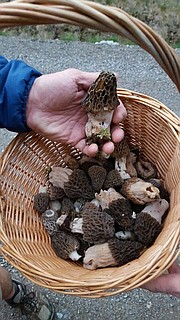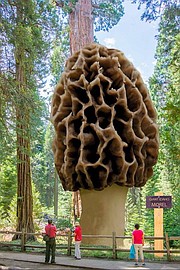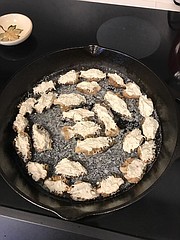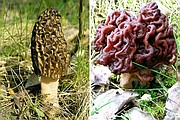The mystique of the MOREL
Morel hunting tip No. 3: "Look for the main fruiting of morels when apple tree leaves are as big as squirrel ears and when lilacs are in bloom."
This wise mushroom-gathering advice comes directly from Tim Gerlitz, longtime club educator for the North Idaho Mycological Association — NIMA — North Idaho's local mushroom club.
"The big flush (of morels) occurs the first two to three weeks in May," Gerlitz said. "The big fruiting begins when soil temps are above 50 degrees."
Morel mushrooms, Morechella esculenta, are a highly sought-after fungal delicacy. They have round, oval or cone-shaped caps that are honeycombed with ridges and pits, giving them the nickname "sponge mushroom."
Don't confuse them with the toxic false morel, Gyromitra esculenta, which grows around the same time. The false morel is brain-like and wrinkled but is not honeycombed with pits like true morels. False morels have red-brown, brown or yellow-brown caps and are usually attached to the stalk at several points but not completely intergrown with it. False morels have a cotton-like substance in the stem while true morels are hollow.
"Many fungophobes (including some mushroom 'experts') delight in issuing dire warnings about mushrooms that are edible under some circumstances and deadly poisonous under others," David Arora wrote in "All That the Rain Promises and More: A Hip Pocket Guide to Western Mushrooms." "These warnings, however, apply only to the false morels, a group that is easily identified."
True morels are safe to eat, but Arora recommends they always be cooked (but they're "delicious fresh or dried"). These elusive mushrooms only grow for two or three weeks a year, making them quite the prize to find.
"They can be very expensive in market," Gerlitz said.
Prices online vary, but some eBay.com users are selling morels for about $40 a pound or more. Black and blond morels are treasures of North Idaho mixed conifer forests, hiding in areas of disturbed ground such as campgrounds, patches of recently logged woods, hiking trails and more.
But they're not always in remote locations, especially when wet winters provide for above-normal growth. Ryan Davis, executive director of the Boys and Girls Club of Kootenai County, recently shared an unexpected morel mushroom discovery that occurred in Coeur d'Alene.
"I watched three Lakes Middle School boys walking around the edge of our newly barked flowerbeds at the Lola & Duane Hagadone Clubhouse. When I approached them and asked what they were doing they excitedly replied they were looking for morels!" Davis posted on his Facebook page.
"I called bull because as a kid we always went into the woods when we would mushroom hunt for grandma. But, sure enough, they had a handful of morel mushrooms, and as we stood there talking they found a couple more. Perfect conditions for growing I guess... Only at a Club in North Idaho!"
So, what's all the fuss about this fungus?
Morels are hard to find because they blend in with brush and leaves on the forest floor. They're rare because their growing season is so short.
And for the right palates, they're delicious.
"Crab-stuffed is our favorite way to eat morels, but we also freeze them and dehydrate them," said Eric Soles of Bayview, who has hunted morels with his wife, Breigh, for about three years.
"We make a lot of wild game dishes — including sausage and salamis, using my great-grandpa's cast iron sausage stuffer, from 1909 — that go incredibly well with morels in them or as appetizers," Eric said. "We make all of our own wine too, so being able to prepare culinary delights from things that we've grown or harvested made us immediate morel-hunting addicts."
Morels are generally considered a medium-sized mushroom, but the giant "bigfoot morel," Morchella crassipes, which has been known to grow to be about a foot tall, has been found in states such as Oregon and Minnesota.
But it's no Morchella giganthapithica, NIMA's large morel equivalent of Paul Bunyan. Embellished photos on the club's Facebook page of house-sized morels make the unsuspecting layman take a second look and wonder, "How come I've never seen this before!?"
It's that mycological humor, of course, putting the "fun" in "fungi."
"'Morchella giganthapithica' is a fun made up name, but we do have some giant footed morels that show up now and then," Gerlitz said. "We have found them in the McCall area, but there are rumors that you can find quite large black and blond morels here in North Idaho."
Tromping through the woods, spending the hours in the middle of nowhere, sometimes leaving empty-handed. This is what mushroom hunters happily do.
"My wife and I got into it together as a way to see more of the North Idaho wilderness that we love about living here," Eric said.
In his field guide, Arora wrote "it takes a certain boldness and curiosity to seek out mushrooms, and creativity to put them to good use," especially in a mushroom-loathing society.
"North American mushroom hunters are an unusually bold, curious, creative, even iconoclastic and bizarre bunch," reads the guide's preface. "Few of us get to write books. Even fewer get to write books about mushrooms. As one who does both, sharing the insights and experiences of those who don't is a fitting way to record a small but significant part of our future history and cultural heritage."
Gerlitz, who was raised hiking and backpacking in North Idaho, has met thousands of people in his 15 years teaching mushroom workshops.
"Once knowledgeable, (morel/mushroom hunting) is a great activity," he said. "Mushrooming is a great endeavor, both spring and fall, in North Idaho and eastern Washington."









